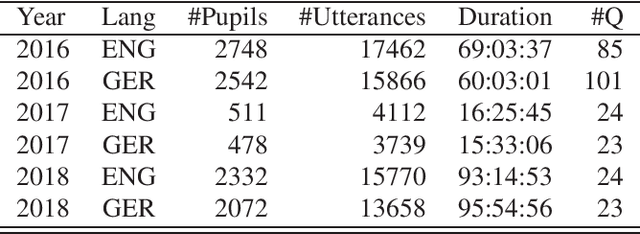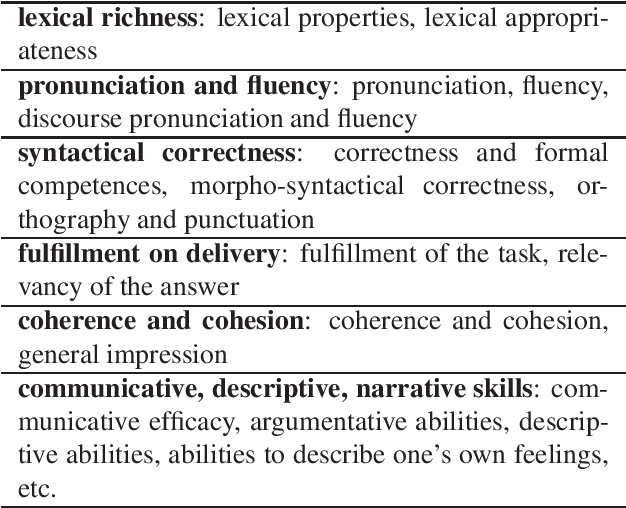Stefano Bannò
LLMs in Education: Novel Perspectives, Challenges, and Opportunities
Sep 18, 2024Abstract:The role of large language models (LLMs) in education is an increasing area of interest today, considering the new opportunities they offer for teaching, learning, and assessment. This cutting-edge tutorial provides an overview of the educational applications of NLP and the impact that the recent advances in LLMs have had on this field. We will discuss the key challenges and opportunities presented by LLMs, grounding them in the context of four major educational applications: reading, writing, and speaking skills, and intelligent tutoring systems (ITS). This COLING 2025 tutorial is designed for researchers and practitioners interested in the educational applications of NLP and the role LLMs have to play in this area. It is the first of its kind to address this timely topic.
Grammatical Error Feedback: An Implicit Evaluation Approach
Aug 18, 2024Abstract:Grammatical feedback is crucial for consolidating second language (L2) learning. Most research in computer-assisted language learning has focused on feedback through grammatical error correction (GEC) systems, rather than examining more holistic feedback that may be more useful for learners. This holistic feedback will be referred to as grammatical error feedback (GEF). In this paper, we present a novel implicit evaluation approach to GEF that eliminates the need for manual feedback annotations. Our method adopts a grammatical lineup approach where the task is to pair feedback and essay representations from a set of possible alternatives. This matching process can be performed by appropriately prompting a large language model (LLM). An important aspect of this process, explored here, is the form of the lineup, i.e., the selection of foils. This paper exploits this framework to examine the quality and need for GEC to generate feedback, as well as the system used to generate feedback, using essays from the Cambridge Learner Corpus.
Can GPT-4 do L2 analytic assessment?
Apr 29, 2024Abstract:Automated essay scoring (AES) to evaluate second language (L2) proficiency has been a firmly established technology used in educational contexts for decades. Although holistic scoring has seen advancements in AES that match or even exceed human performance, analytic scoring still encounters issues as it inherits flaws and shortcomings from the human scoring process. The recent introduction of large language models presents new opportunities for automating the evaluation of specific aspects of L2 writing proficiency. In this paper, we perform a series of experiments using GPT-4 in a zero-shot fashion on a publicly available dataset annotated with holistic scores based on the Common European Framework of Reference and aim to extract detailed information about their underlying analytic components. We observe significant correlations between the automatically predicted analytic scores and multiple features associated with the individual proficiency components.
Towards End-to-End Spoken Grammatical Error Correction
Nov 09, 2023Abstract:Grammatical feedback is crucial for L2 learners, teachers, and testers. Spoken grammatical error correction (GEC) aims to supply feedback to L2 learners on their use of grammar when speaking. This process usually relies on a cascaded pipeline comprising an ASR system, disfluency removal, and GEC, with the associated concern of propagating errors between these individual modules. In this paper, we introduce an alternative "end-to-end" approach to spoken GEC, exploiting a speech recognition foundation model, Whisper. This foundation model can be used to replace the whole framework or part of it, e.g., ASR and disfluency removal. These end-to-end approaches are compared to more standard cascaded approaches on the data obtained from a free-speaking spoken language assessment test, Linguaskill. Results demonstrate that end-to-end spoken GEC is possible within this architecture, but the lack of available data limits current performance compared to a system using large quantities of text-based GEC data. Conversely, end-to-end disfluency detection and removal, which is easier for the attention-based Whisper to learn, does outperform cascaded approaches. Additionally, the paper discusses the challenges of providing feedback to candidates when using end-to-end systems for spoken GEC.
L2 proficiency assessment using self-supervised speech representations
Nov 16, 2022Abstract:There has been a growing demand for automated spoken language assessment systems in recent years. A standard pipeline for this process is to start with a speech recognition system and derive features, either hand-crafted or based on deep-learning, that exploit the transcription and audio. Though these approaches can yield high performance systems, they require speech recognition systems that can be used for L2 speakers, and preferably tuned to the specific form of test being deployed. Recently a self-supervised speech representation based scheme, requiring no speech recognition, was proposed. This work extends the initial analysis conducted on this approach to a large scale proficiency test, Linguaskill, that comprises multiple parts, each designed to assess different attributes of a candidate's speaking proficiency. The performance of the self-supervised, wav2vec 2.0, system is compared to a high performance hand-crafted assessment system and a BERT-based text system both of which use speech transcriptions. Though the wav2vec 2.0 based system is found to be sensitive to the nature of the response, it can be configured to yield comparable performance to systems requiring a speech transcription, and yields gains when appropriately combined with standard approaches.
Proficiency assessment of L2 spoken English using wav2vec 2.0
Oct 24, 2022



Abstract:The increasing demand for learning English as a second language has led to a growing interest in methods for automatically assessing spoken language proficiency. Most approaches use hand-crafted features, but their efficacy relies on their particular underlying assumptions and they risk discarding potentially salient information about proficiency. Other approaches rely on transcriptions produced by ASR systems which may not provide a faithful rendition of a learner's utterance in specific scenarios (e.g., non-native children's spontaneous speech). Furthermore, transcriptions do not yield any information about relevant aspects such as intonation, rhythm or prosody. In this paper, we investigate the use of wav2vec 2.0 for assessing overall and individual aspects of proficiency on two small datasets, one of which is publicly available. We find that this approach significantly outperforms the BERT-based baseline system trained on ASR and manual transcriptions used for comparison.
TLT-school: a Corpus of Non Native Children Speech
Jan 22, 2020



Abstract:This paper describes "TLT-school" a corpus of speech utterances collected in schools of northern Italy for assessing the performance of students learning both English and German. The corpus was recorded in the years 2017 and 2018 from students aged between nine and sixteen years, attending primary, middle and high school. All utterances have been scored, in terms of some predefined proficiency indicators, by human experts. In addition, most of utterances recorded in 2017 have been manually transcribed carefully. Guidelines and procedures used for manual transcriptions of utterances will be described in detail, as well as results achieved by means of an automatic speech recognition system developed by us. Part of the corpus is going to be freely distributed to scientific community particularly interested both in non-native speech recognition and automatic assessment of second language proficiency.
 Add to Chrome
Add to Chrome Add to Firefox
Add to Firefox Add to Edge
Add to Edge